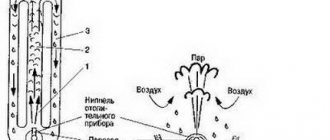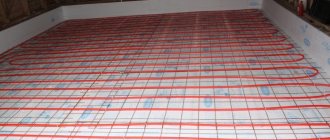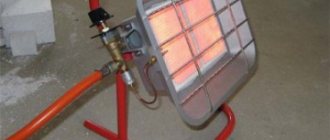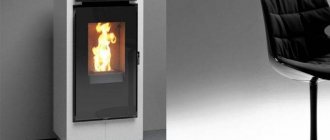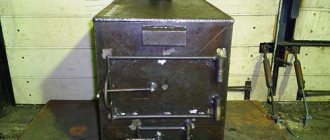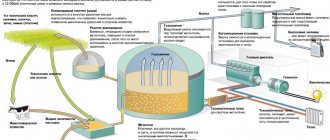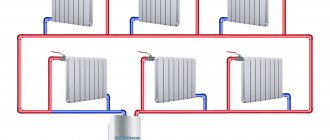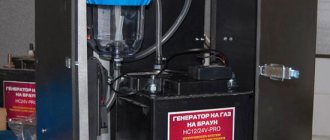Heating system in a smart home
The air temperature in the house depends on the efficient operation of heating devices, the heat output of which must compensate for the thermal losses of the building; the level can vary depending on weather conditions: wind speed, humidity, time of day.
A simple relationship arises: the higher the heat losses (or, the worse the weather), the greater the heat transfer the heating devices must provide and the greater the amount of heat the heating boiler must produce.
Heating control
You can control the operation of the boiler manually by increasing or decreasing the fuel supply to the combustion chamber. But, you see, it is better if the heating boiler can determine for itself how much heat it needs to generate and how much fuel it needs to burn for this.
General principles of a heating system in a smart home
You can adjust the heating operation in different rooms with a single heating system, only using thermostats and a “smart home”.
For the system to function, a properly organized network of devices is needed. It must take into account the operating features of each component, adjust their parameters, and all this is connected to the unit.
At the initial stage, a diagram is developed that predetermines the arrangement of the system and the connection of all sensors. The diagram is drawn on a drawing, where it is determined which components will be used. Relays can be connected to the boiler, thermostats, valves, sockets or other components - it all depends on the features of the controller and heating system.
The controllers can be used to connect any system powered by electricity.
The general principle of a heating system in a smart home is how the network of heat exchangers will be formed and how it will be connected to the unit. In this case, in addition to pipes and radiators, a boiler and various sensors are connected to the controller. Depending on the functionality of the control unit, other systems are also connected to it, which will be controlled through the “smart home” complex.
Modern heating boilers
Boiler equipment is still in demand, but traditional heating units have been replaced by new devices that meet all quality criteria and have very decent technical characteristics.
Condensing boiler
The operation of a new type of heat generator is based on the formation of carbon dioxide and water during the combustion of fuel, releasing a large amount of energy. The design of such a boiler includes a combustion chamber with a burner, a fuel supply system and a fan for forcing air, as well as an after-cooling chamber and a reservoir in which condensate is collected.
The efficiency indicators of a gas condensing boiler reach 97% (for traditional ones a maximum of 93%), which significantly exceeds similar data for equipment operating using liquid and solid fuels. In this way, you can achieve not only maximum efficiency of the autonomous heating system, but also make energy consumption as economical as possible.
Many European countries are abandoning the use of traditional gas boilers and are switching to a modern new solution in heating systems - condensing boilers.
Wall-mounted gas boilers
Floor-standing versions have been used less and less lately. The installation of wall-mounted models operating on liquefied or main gas is becoming relevant. It provides not only heating of the premises, but also uninterrupted hot water supply to the house. Wall-mounted equipment has a number of advantages, including compact dimensions and a completely modern design.
From a design point of view, devices with an open and closed combustion chamber in single- and double-circuit versions differ. When choosing a model, it is advisable to focus on the power indicators of the unit, its dimensions (especially important in small rooms), as well as the presence of the necessary functionality.
In terms of efficiency, only condensing boilers can compete with wall-mounted gas boilers, but they are also quite expensive.
Electric boiler with automation
The last word in arranging a heating system for a country house is electric boilers, equipped with weather-dependent automation or an option for automatic increase/decrease of power. A whole range of additional expensive equipment provides fuel consumption control and also prevents excessive cooling or severe overheating of the air in the room.
The cost of such boilers is quite high, but the advantages of operation are quite obvious. There is no need to regularly manually change temperature settings depending on weather conditions. Well-proven models are durable and easy to maintain, have a high degree of reliability and are safe to use.
Coal-fired bunker-type boilers
If you look at new solutions in heating systems based on coal boilers, bunker solutions stand out. Bunker-type solid fuel units differ in the capacity of the built-in fuel tank and other important technical characteristics. The high demand for such models is due to an automatic screw fuel supply mechanism, forced air injection and removal of combustion products, and a self-cleaning function.
In devices of the new type, uninterrupted operation is ensured by a microprocessor controller and an electric ignition system. When fuel is supplied in portions, complete combustion occurs and a minimum amount of unburned fuel is observed with maximum thermal output. Bunker equipment is most often equipped with a retort burner or an AKM burner device.
What does a smart home heating system consist of?
You can control a “smart home” not only using a computer and a controller, but also using a smartphone, tablet or other device.
In addition to the heating system itself, which includes radiators, a boiler, valves and pumps, the “smart home” complex should include various control elements . How the complex will be formed is determined by the drawings and features of the already installed devices. Most often a GSM controller is used, in which case the following components are required:
- temperature sensors - usually no more than 2-3 of them are used, depending on the type of controller and its functions;
- a unit with a GSM module or Ethernet protocol to control heating via the Internet;
- antenna for receiving a GSM signal, Ethernet or Wi-Fi adapter for interaction with other devices of the smart home system;
- leakage sensors - ensure safe operation, even with remote control;
- key scanner or other access control mechanism;
- battery for autonomous operation of all system components;
- connecting wires and power cables;
- boiler control pads.
This equipment is standard for a GSM smart home heating system in which it is connected via a boiler and pads. In conditions where the complex is connected to an already installed system, the set of devices is selected individually.
The system can be placed on the ground floor, in the basement
Typically, in addition to standard radiators, additional heating devices are used: a “liquid floor” system, fireplaces and other interconnected heating devices. In this case, automation will require more sensors and control modules.
Automatic maintenance of above-zero temperature
The water supply is directly related to heating. If a trip to the dacha in winter is something out of the ordinary, there’s no need to worry too much about the plumbing. You can bring water with you for a day or two, or store it in plastic containers from the summer, and melt it if necessary.
It’s another matter if such trips occur frequently, and the water, in addition to drinking, is used for showering and for sewage. That is, the dacha exists in the mode of a country house. This requires systems smarter than a simple remote switch.
Constant freezing and thawing in such a situation will lead to damage to the finishing of the house and will ultimately cost the owners more than maintaining a constant above-zero temperature. That is, 1-2 degrees Celsius. It is only necessary to warm the room to a comfortable temperature periodically.
I recommend: Choosing the right heated floor - advice from professionals
We will assemble a more complex system, which will include not only room heating, but also electric heating of water supply and sewer lines, as well as constant maintenance of a low but positive temperature.
Expensive models of liquid and gaseous fuel boilers equipped with a thermostat have similar functions. But since we decided that this is not our case, we will use electric heating.
You can read how to heat a sewer in the article about → shallow-depth sewers. Heating the water supply is done in the same way. To do this, the pipe is wrapped in a spiral with a heating cable cord, and the top is covered with a warm sleeve made of foamed polyethylene.
To heat the water supply we use a heating cable and an insulating sleeve
Let's supplement our control system with a GSM module with one more circuit.
To do this, we use relays with temperature sensors set to 1÷3°C. We place the sensors on the floor, in the corners formed by the outer walls. In these places the temperature drops the fastest.
The water supply must always have a positive temperature, otherwise the water will freeze and burst the pipes. In order not to keep the heating cable constantly on, we also attach a temperature sensor to the pipe and connect it to a thermostat set to +3.
Now let's see how this will all work.
As long as the temperature outside and, accordingly, in the house is above zero, nothing happens. It's starting to get cold. The temperature drops below +1, sensors on the pipes and (or) in the room give a command, the relay closes the contacts and supplies voltage to the heaters.
The heaters raise the temperature to +3, the thermostat relay is activated again, turning off the current. In this mode, the house maintains itself until you call.
Having received a telephone command, the GSM module, as before, closes the electrical circuit of the heaters. But since now we are not in danger of freezing the water supply, we will also add a boiler for heating water to the air heaters (see diagram in Fig. 1).
Connection diagram for electric heating of a smart home
One phone call is enough to restore it to its original state. After it, the circuit is turned on again through the thermostat and goes into slumber until our next visit.
Features and benefits of a smart home heating system
Remote control of the heating of an apartment or country house allows you to control the temperature in the room, even when you are far from it. But this is not the only advantage of this system. Users point out the following advantages:
- The indoor climate corresponds to the set settings, even if the owner did not monitor the operation of the heating devices.
- Automated control helps to significantly reduce gas and electricity consumption.
- Malfunctions will be detected in a timely manner; the computer eliminates the human factor.
- The system allows you to combine heating devices and simplifies their control.
The disadvantage of smart home heating is the high price (especially of the control unit) and complex installation. Not every specialist can handle the installation of the complex, even if there is a detailed drawing, and only specialized specialists can adjust and configure it.
The price of smart heating is high, as is the cost of installation - these are the main disadvantages. This leads to other disadvantages of the system: the high cost of repairs, the difficulty of connecting additional components and replacing them.
To avoid high costs in the future, it is important at the initial installation stage to organize the operation of the entire complex and configure it as needed. The main cost item during installation will be the control unit, even with a large number of sensors and thermostats.
Comfortable climate control
Heating control provides exceptional comfort:
- Each room will be precisely maintained at the temperature you require. If you want it cooler in the bedroom, and warmer in the living room - please!
- The required temperature is maintained in specialized rooms: in the wine cellar 18 degrees, in the pool 25 degrees, in the garage 12 degrees, etc.
A controlled climate will do all this with ease.
Change in room temperature over a week without climate control
Organization of heating control
In the Western market, there is a larger selection of programmers and controllers - but they usually do not have Russian localization.
Thermal conductivity of ceilings, partitions and walls, the quality of insulation in them, the implemented heating system and the method of heat distribution - these are all components of the climate inside a building. Radiators, “warm floors”, boilers, boilers play an important role here - this can be controlled using one control unit.
Controllers and programmers help configure the operation of any systems included in a “smart home”, and not just control home heating. Communication between all systems occurs through local units and executive relays, and their operation is monitored using sensors.
All components are in turn connected and configured in the main control unit. The list of systems that can be connected depends on the model and functionality of the latter.
Conclusions about heating systems in a private home
Purchasing profitable heating of a private home with electricity is quite simple - you need a source of economical and safe electricity. The thing is that classic electric heaters of the old generation are extremely expensive. And replacing the heating system with a modern one with electronic control of electricity consumption is quite simple. Economical heaters for heating a private home exist, but they are much more expensive than their simple, expensive counterparts. Achieving savings in new generation heaters is achieved through the use of automation with an electronic component, which allows reducing electricity consumption by 50% of the rated power.
Remote control of the heating system
The ability to remotely configure heating network parameters is the main advantage of the complex.
All heating system controllers included in the “smart home” category are divided into two categories: local and zonal.
Local control units are systems that control the climate inside the house as a whole, regulating the operation of the entire heating system, including “warm floors”, radiators, boilers and zone heaters.
Zonal control units are devices that control the operation of a specific element of the heating system, for example, only “warm floors” or “boiler and radiators”. In both cases, the controllers can work with remote control, via GSM, Ethernet, Wi-Fi or other modules.
Via GSM unit
In units working with the GSM module, the ability to configure and change parameters using SMS messages is implemented. This is convenient for setting up without the Internet, but is considered a disadvantage due to the demands on the quality of the cellular network.
A controller in this category operates using GSM networks, so it must be used in accordance with the characteristics of the region, and can only be installed at a certain height.
Domestic heating system control units are no worse than Western ones, but they look less attractive.
GSM controllers for smart homes are being replaced by Ethernet modules on the market. Due to the complexity of setting up, local controllers are available with Internet connectivity. Zone modules can be used with the GSM protocol (for example, regulation and control of hot water entering radiators). Such controllers have a simple design, simple setup (via SMS), convenient control and an alert system.
The following types of models are suitable for zonal control:
- GSM-Thermometer “Telemetrics” - simple setup, 4 relays for control, convenient mobile application;
- GSM-Thermometer “Warm House 22” - presence of a display, several operating modes that can be switched by buttons or SMS, thermometers are connected by a telephone cable;
- TS2 GSM v6 – complex setup, but great functionality, ability to connect to the device via an application, convenient display;
- Climate ZONT-H1 GSM – inconvenient interface, setting parameters via the manufacturer’s website, working with 1 relay.
Most modern controllers have built-in GPS and Ethernet modules, which allows you to choose convenient control in certain conditions. The connection is made through circuits that are installed inside the heating system, and connected to the complex itself via a “relay”.
Ethernet
In the smart home system, heating can be controlled via the Internet connection. To do this, the installed control unit must have the appropriate module and support an Ethernet connection. Unlike GSM controllers, they allow several users to work through the software at once.
The list of gadgets available for connection depends on the software of the control unit and its firmware, as well as the model; most can work with smartphones, PCs, laptops and tablets. Another advantage is that setting parameters in such controllers is available anywhere in the world where there is Internet access.
Most modern programmers and controllers have built-in both GSM and Ethernet protocols
Unlike programmers and GSM controllers, control units with the ability to connect via the Internet have the following advantages:
- There is no limit on the number of users.
- You can configure settings by connecting to a network anywhere in the world.
- User-friendly interface.
- Possibility of integration with voice assistants “Google Assistant” or “Alice”.
- You can configure such controllers without the help of a specialist.
Since there is no link to the number, identification of the owner plays an important role in such blocks. Most people choose a PIN code as protection, but you can use voice identification, fingerprint or FaceID.
In domestic units that operate remotely via the Internet, an Arduino module is usually used, which can be adapted into any circuit for remote control. But you can also use other models with Internet relays.
Heating system selection: electric heating system
Choosing a heating method for your living space can be as simple as it can be quite complex. It is important to consider all options before making a final decision. Choosing the wrong heating system can result in huge financial losses, as well as providing you with either too little or too much heat. The best way to choose the right heating is to carefully analyze your needs, the current heating market and its trends.
At the moment, the main types of heating are: water, air, stove and electric. Each option has its advantages and disadvantages, however, in most cases, electric heating is an excellent option for most apartments and houses as primary and secondary heating.
We believe that there are several main reasons why you should consider electric heating, namely TeplopitBel quartz heaters: ease of installation, cost-effectiveness, efficiency, safety, environmental friendliness, comfort.
District heating control
In centralized heating, thermostats and thermostats of electronic and mechanical types are used.
Unlike installing a controller and relay in a private house, when installing centralized heating for an apartment building, the system will be different. In this case, it is necessary to connect sensors to each pipe, and the controller must provide autonomous heating, and not remote control. But via GSM or Ethernet, the control unit can transmit statistical data or information about the heating status.
A central heating system uses modules with specific relays, sensors and thermostats. Ethernet protocols and remote control are not needed here - automation according to preset parameters plays an important role in the DSP. The complexity of installing this equipment does not allow you to install it yourself - this should be done by a specialized specialist.
Features of organizing a heating system in a smart home
How to assemble a smart home system, connect heating and remote control, as well as other complexes (ventilation, air conditioning, lighting) is a question that should be resolved at the stage of planning the house and the system as a whole. It all depends on the selected control module, its capabilities and the number of relays.
For example, if a module with 12 channels is installed (for example, MP716 Laurent-112), then you can connect up to 12 points for subsequent control, and then the “smart home” plan will be radically different from a system with 6 channels.
Thus, first you need to buy a controller, and then relays, sensors and other components of a “smart home”. This is also due to the fact that different units may have different protocols (Z-Wave is different from ZigBee, and so on), so you need to select not components for the controller, but vice versa.
Recently, Xiaomi has been supplying its own controllers to the market.
After purchasing the control unit, you can plan the heating system. The centralized local controller must have a direct connection to all zone relays (if used) or to each of the heating elements. If only radiators and a boiler are connected to the smart home, they can be controlled using thermostats or other sensors installed at the outlet of the radiators.
How to form a network of devices and relays, you need to understand the layouts individually - but it is important to follow the logic and take into account the peculiarities of the local power grid.
Heating using an electric boiler
In this article we will not go into explanations of the operating principles of each type of boiler, since this is written and talked about on every corner. We will look at electric boilers as a general system for organizing electric heating in your home.
An electric heating system with a boiler involves its operation to heat the coolant, and pipes to deliver the heated liquid to the radiators, which, in turn, transfer thermal energy to the air space and the environment, thereby creating a comfortable temperature for humans.
The main and most popular types of electric boilers:
- heating elements new
- Induction
- Electrode
Note that today induction boilers are considered the most efficient compared to others.
From a cost point of view, a system with electric boilers will be the most expensive heating system among the others. To organize such a system, the electric boiler itself, the coolant, pipes, radiators and additional auxiliary elements necessary for operation are required: a circulation pump, an expansion tank, safety and control attributes, as well as shut-off and control valves.
It is important to understand that when we choose from different types of electric heating, we must not forget how well the thermal insulation of your home is made and what kind of heat loss it has. We gain from 10 to 30% on heating savings, but if you don’t take care of home insulation, you can lose 2-3 times more!
Tips for selecting components and setting up system management
The right decision would be to order a turnkey “smart home” installation.
If you decide to integrate a control unit into the heating system, which will allow you to remotely configure its operation, then it is important which model will be purchased. Of those presented on the market, units of both zonal and local types are relevant. You can buy already assembled control units or purchase modules with relays that can be configured as programmers through official software. Ready-to-install controllers with a display, regulators and a set of modules have a higher price than modules with relays.
Athom Homey is the best model on the market, but it also has the highest price
It is important to immediately decide which protocols it will work with - not all devices can be integrated using Z-Wave or ZigBee standards. If it is not possible to understand the program code, then you should only buy ready-to-use, assembled “smart home” units. They work in different standards, but all are ready to use immediately after installation:
- Fibaro Home Center 2 – compatible with Google Assistant, has an Ethernet connection, works via the Z-Wave standard;
- RaZberry is an inexpensive device with limited functionality, works via the HomeKit standard, can be configured via a PC;
- VeraPlus is a multifunctional controller that works with most standards (including Z-Wave and ZigBee), user-friendly interface, easy setup via a computer and smartphone;
- Athom Homey is the best controller in terms of functionality, compatible with all standards (including integration with Alice), easy setup, support for all necessary protocols, but a very expensive model.
The range of boards with executive relays is much larger. These include the well-known “Arduino” module, the program code of which is in open sources and can be customized in accordance with user requests. A set of such modules can be combined into a single system, where remote control of both heating and other components of the smart home system will be carried out, to which any electrical appliances can be connected.
The smart home system can connect not only heating, but also ventilation, plumbing, lighting and other elements of a modern home that run on electricity
Programmers are fundamentally different - these are systems equipped with thermostats, thermometers, leakage and humidity sensors by default. They use from 1 to 16 circuits, which allows for precise control of heating.
Remote control systems are not relevant for use in centralized heating. In boiler rooms of apartment buildings, automation devices are used that control the temperature and turn off a certain pipeline or the entire boiler at the required levels. Programmers are suitable for these purposes; in the parameters you can enable SMS alerts, but control is carried out using knobs, buttons and a display.
